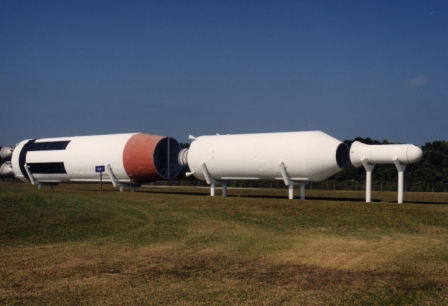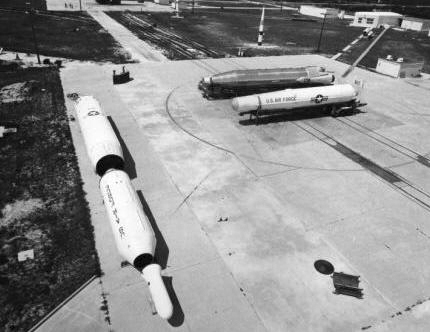
Photo Gallery
Exhibit Overview
Display location:
Type: Intercontinental Ballistic Missile (ICBM) with Mark IV reentry vehicle nose cone
Designations: SM-68 / HGM-25
Serial Number: 57-2691
Payload: nuclear warhead
Agency: U.S. Air Force
Contractor: The Martin Company
Cape Canaveral Space Force Station Operations: 1959-1962
History
As a follow-up to the Atlas, the Titan I provided the U.S. Air force with a more advanced intercontinental ballistic missile (ICBM) affording increased range and payload capability. A development contract for the Titan I was issued to The Martin Company in October 1955 (before firing of the first Atlas missile).
Management of the program was controlled from their new Denver, Colorado facility. The missile was initially designated the SM-68. Joe Rowland, Martin Company public relations, suggested the name “Titan” after the Greek mythological father of Zeus.
Titan I Design
The Titan I was a two-stage missile, which was larger, but lighter, than the Atlas. Improvements in engine technology and guidance systems caused the Titan I to eclipse the Atlas in a relatively short time. The Titan I employed a powerful dual-chambered first stage engine (each capable of providing 150,000 pounds of thrust) and a single-chamber second stage engine with 80,000 pounds of thrust.
AVCO Manufacturing Corporation developed the Titan I re-entry vehicle which consisted of a structural assembly, heat dissipation system, stabilizing system and nuclear warhead. The inertial guidance originally intended for use on the Titan I was transferred to the Atlas program. Instead, a redesigned radio controlled guidance system from the Western Electric, Sperry and Remington Rand Univac was employed.
Launch
The first test launch of a Titan I occurred on 6 February 1959. For this flight, only an operational first stage was employed. A dummy second stage used water as ballast.
The Titan I was one of the earliest rocket displays to arrive at the museum.
Related Pages:
- Titan Inertial Measurement Unit
- Titan Guidance Computer
- Titan I Second Stage Engine
- Titan Locomotive
- Titan Archived Photographs
- CCSFS Launch Complex 15
- CCSFS Launch Complex 16
- CCSFS Launch Complex 19
- CCSFS Launch Complex 20
